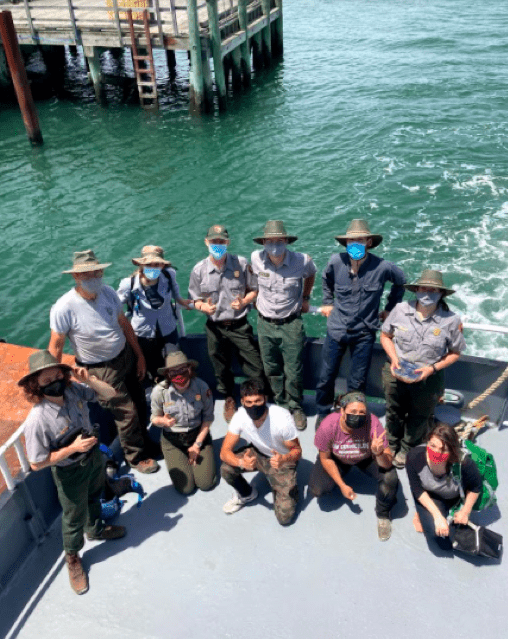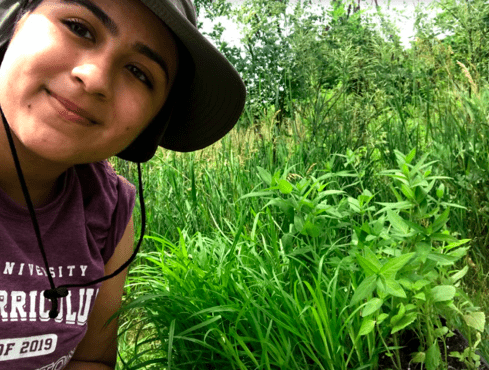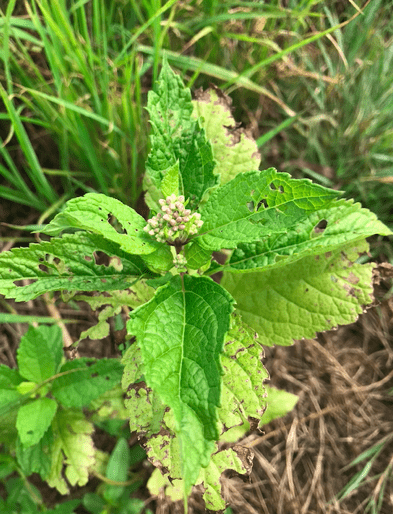Digging Deeper Into the History of Joe the Plant and Joe the Human
Written by: Melissa Hurtado

Hello all, thanks for tuning in on today’s episode of brief histories with Melissa.
Today I’ll be taking you back in time and back to the present day in one article with a single plant species!
Part of my internship involves helping out with the revegetation project at the Boston Harbor Islands. The project’s goal is to plant native plants in order to restore and protect current ecosystems from climate change and other environmental threats. The way this works is a team of park rangers, interns, and volunteers head out to the islands (Thompson and Grape Island) via boat or ferry and transplant seedlings of a variety of native species into the ground. Some of these include: Switchgrass (Panicum virgatum), Sallow Sedge (Carex lurida), Canada Goldenrod (Solidago canadensis), and Spotted Joe Pye weed (Eutrochium maculatum).

Each of these plants require a specific planting location and soil type on the islands and so every time we plant a seedling into the ground, we are very careful to choose a location in order for it to be successful. The locations typically include uplands, wetlands, and wetland adjacent. Spotted Joe Pye Weed for example, is a wetland and wetland adjacent plant. This means it likes relatively wet soil and lots of sunlight.


Spotted Joe Pye Weed is native to Massachusetts and is a type of Joe Pye weed. You can identify Spotted Joe Pye Weed through its unique round, fuzzy-like purple or purple spotted stem. It has serrated edges along the leaves and conscious veins. Sometimes you can see its purple and pink flowers occurring in flat-headed clusters. See picture below.

Spotted Joe Pye Weed is one of the species we are planting in the Harbor Islands this summer. Shown here is a Spotted Joe Pye Weed that was planted last year as part of the revegetation project. Can you name some of its identifying markers?

There are many different types of Joe Pye Weeds other than Spotted including Coastal and Sweet Joe Pye Weed. But who is Joe Pye? And why is he named after this weed?
The story that you may have heard about why Joe Pye Weed got its name is that it was named after a medicine man living in New England in the late 16 and early 17 hundreds who cured typhus and other fevers using this plant. This story is even recorded in the early herbalist books, first being recorded in Amos Eaton’s botany manuals describing how the plant was common medical use in the western counties of Massachusetts. Despite vague details on Joe Pye’s life, a 2017 study by Richard Pierce and James Pringle brought to light more details of who Joe Pye actually was.

Joe Pye, better known as Joseph Schauquethqueat (biblical first name and Indigenous surname) was a Mohican, or Mohegan, Sachem from New York. He was known as Joe Pye, his alternative surname, by white townspeople. Although the myths describe Schauquethqueat as a medicine man, there is little to no evidence that he was. Schauquethqueat lived in the mission town of Stockbridge, Massachusetts from around 1740 to 1785. Schauquethqueat along with his tribe relocated to Stockbridge due to war conditions and disease. There, he befriended Samson Occom and shared heart exercises (prayers), according to Occom’s diary. Occom was known to be a herbalist which may be connected to why people may have called Schauquethqueat a medicine man. However, there is no evidence that Occom consulted with Schauquethqueat on Joe Pye Weed. Pierce and Pringle suggest in their 2017 study that Mohicans lived in Stockbridge and that either them or Schauquethqueat could have used this plant or been seen using it by white townsfolk. Since Schauquethqueat was a sachem white townsfolk may have attached his name to it since he may have been a common point of contact, ultimately giving it its name, Joe Pye Weed. Schauquethqueat may have not been a medicine man but his memory lives on as we continue to plant Joe Pye Weed in the Boston Harbor Islands, coming to a full circle.
Pierce and Pringle’s 2017 study helped us to learn more about Schauquethqueat’s life but what would the study have looked like if they were able to incorporate oral histories or work with descendant communities who may have more knowledge of how Joe Pye Weed was and is used?
